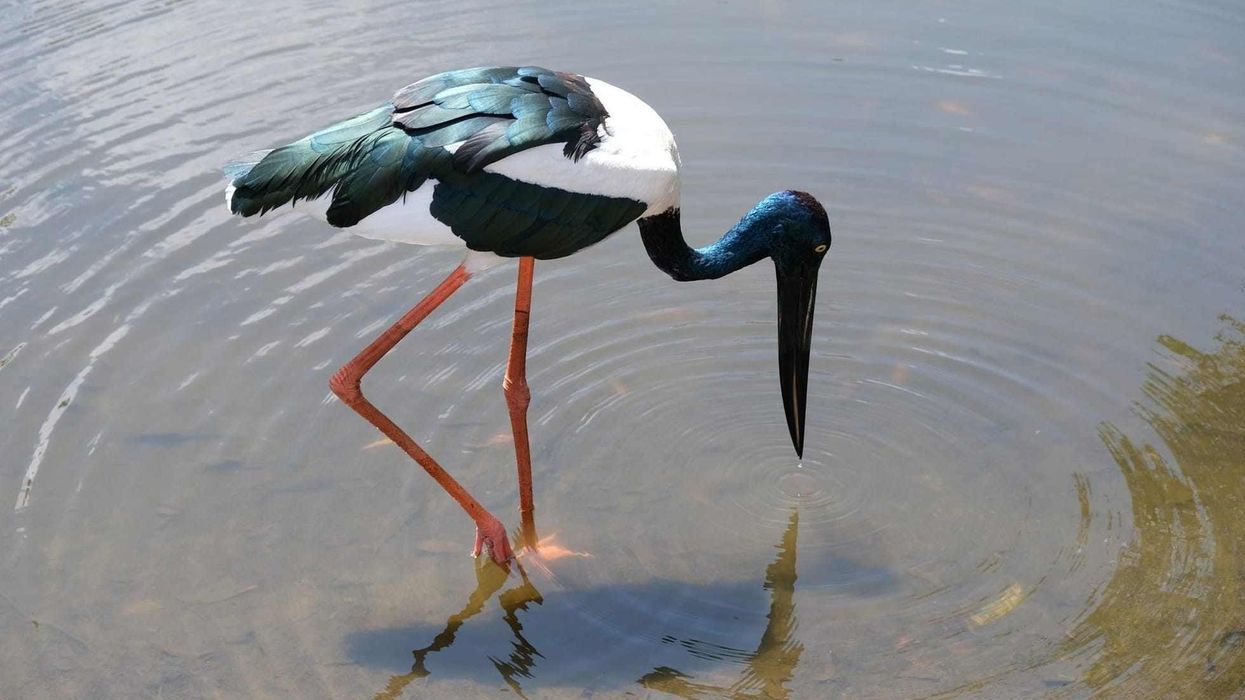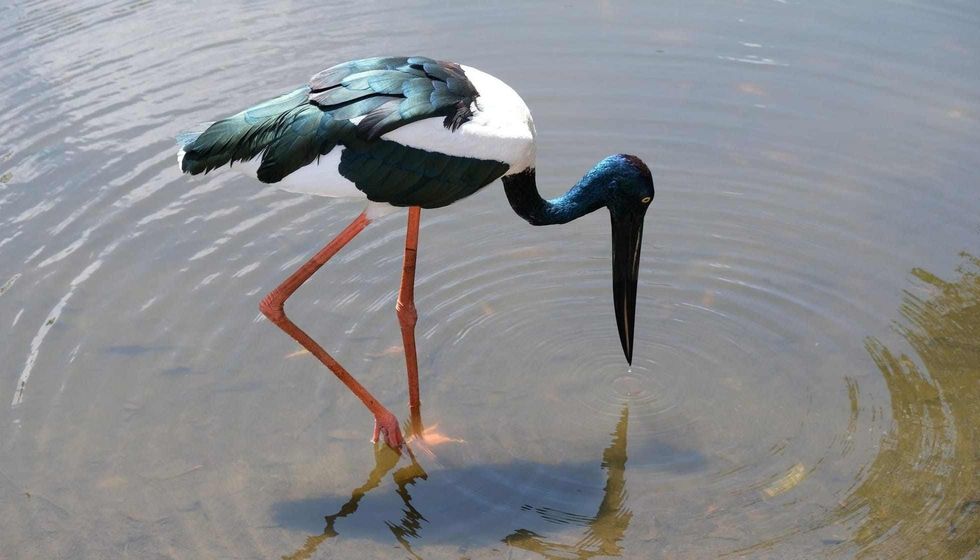Neither fully black nor fully white. The plumage of the Ephippiorhynchus asiaticus, commonly known as the black-necked stork, is a beautiful combination of both these colors. Though the name indicates only the necks, these birds have a black hue for their secondary flight feathers, tail, and head as well, adorned with a beautiful green and purple sheen.
This is a popular bird spread across the regions of Southeast Asia, the Indian Subcontinent as well as Australia. Fish, frogs, and eggs are all a part of this bird’s diet, plucked and grasped with its long, black bill.
Need a quick tip in distinguishing the male and female birds of the family Ciconiidae? Just look at its eyes! The female stork has yellow eyes, whereas the male has black eyes.
A large bird, Australians know this species by another name - the jabiru! This bird is very territorial.
Impressed by these amazing facts about the black-necked stork? You may also enjoy reading our articles on the wood stork and the wandering albatross!
Black-Necked Stork Interesting Facts
What type of animal is a black-necked stork?
The black-necked stork is a type of bird.
What class of animal does a black-necked stork belong to?
These black-necked storks come under the class of Birds and belong to the family Ciconiidae.
How many black-necked storks are there in the world?
The population of this stork family is scattered throughout the world, and making reliable estimates of their numbers is difficult. Thus, there is no exact count on the number of individuals of this species.
Where does a black-necked stork live?
These birds live near freshwater habitats, and agricultural and artificial wetlands.
What is a black-necked stork's habitat?
These birds are found mainly in natural wetlands and freshwater regions. Lakes, swamps, ponds, rivers, water meadows, and flooded grasslands are some of the common places you would find these birds. Artificial wetlands such as sewage ponds, flooded wheat and paddy fields, and irrigation ponds are also inhabited by these birds.
Who do black-necked storks live with?
The black-necked stork usually lives alone or lives with their partner.
How long does a black-necked stork live?
These birds have a lifespan of about 30-33 years.
How do they reproduce?
It has been noticed in India that these birds begin building their nests usually between the months of September to November, with a few birds taking their time and making their nests by January. These nests are made with branches, sticks and have an inner lining of water plants.
Usually, the clutch size is four eggs, though it may vary between one and five eggs. The incubation time is about a month.
The chicks soon hatch, and their primary feathers develop after the scapular ones. Food is given to the young chicks by the adults in regurgitated form.
To prepare the young birds for adulthood, the parents begin showing aggression to the little ones. The chicks might stay in the nests for up to a year before they disperse.
What is their conservation status?
The IUCN has listed the conservation status of the jabiru as Near Threatened.
Black-Necked Stork Fun Facts
What do black-necked storks look like?

This bird is quite large in size. As the name suggests, this bird's plumage is not entirely black but parts of their bodies are white as well.
The adults of this species have a dark blue-black hue for many parts of their anatomy, which includes their secondary flight feathers, necks, head, and even their tails. These parts have a green and purple shimmer.
They also have a copper-tinted crown. They have a long, black bill that is sharp enough to pluck fish out of the water. The upper edge of their bill is slightly concave.
They possess a beautiful bright white belly and dark legs, usually in a bright red shade. Their backs are also white in color and both the genders of this bird look almost familiar, but the males have a brown iris, whereas the females have a yellow iris.
A small chick who is younger than six months of age does not have a yellow iris, but a brown one. Its bill is straighter, yet small.
These black and white chicks have a fluffier appearance. The plumage of the young birds has brown hues on their tails, upper back, wings, head, and neck. They have a bright white belly and dark legs.
The ones who are older than six months of age display a mottled look on their necks and head. Their inner primary feathers are white, whereas the outer primary feathers begin turning a dark shade of brown.
Their bill grows in size and is heavy, however, they remain straight. The legs of the brown juveniles slowly begin turning to dark pink, which further in time becomes paler.
How cute are they?
We find these big birds absolutely cute!
How do they communicate?
The black-necked stork chicks make a distinct 'chack-wee-wee-wee' sound like a call for their parents. Adults usually take turns looking after the baby chicks.
When one of the breeding pairs returns back to the nest to take over the parenting duties, they greet each other by spreading their wings wide open and bobbing their heads up and down. Usually, these birds are quiet, although they sometimes make low-pitched bill clattering sounds, which are closed with a sigh.
The brown juveniles make high-pitched whistling sounds towards their parents.
How big is a black-necked stork?
The black-necked stork has a height of 51-59 in (1.3-1.5 m). Their wingspan is really wide, extending up to 91 in (2.3 m).
Their heights equal twice the height of an adult male Dobermann.
How fast can a black-necked stork fly?
We do not have information related to their flying speeds.
How much does a black-necked stork weigh?
The available records of this bird’s weight have specified it to be about 9 lb (4.1 kg). However, it is said that these birds weigh much more, and this weight was probably of a malnourished black-necked stork or one of the smaller birds of this kind.
What are their male and female names of the species?
There are no different names for these male and female water birds belonging to the order Ciconiiformes.
What would you call a baby black-necked stork?
Though there is no exclusive name for the young black-necked storks, babies of birds are usually called hatchlings, chicks, or nestlings.
What do they eat?
Black-necked storks have a big carnivorous diet. Aquatic vertebrates are a common constituent of their meals, which comprises fish, frogs, reptiles, and other amphibians too. Even invertebrates fall prey to these black and white birds.
Crabs, mollusks, and insects are often plucked by its long bill. It does not even hesitate to eat other, smaller, water birds, including little grebes, pheasant-tailed jacana, darters, northern shovellers, and even coots.
They also feed on the hatchlings and eggs of other animals, such as turtles. Sometimes, they even mistakenly munch down pebbles, plastic, cattle dung, and other plant materials such as leaves, roots, and stems. Australian black-necked storks hunt for food during the night as well.
Are they dangerous?
These birds generally avoid human contact as they are shy. They prefer living by themselves and they are really aggressive.
Would they make a good pet?
We would not recommend keeping these big birds as pets due to their large size, and the fact that they are wild animals. They should be left in the wilds of eastern Australia, northern Australia, New South Wales, and New Guinea.
Did you know...
In places where there are many species of large waterbirds, the black-necked storks are least abundant.
The black-necked stork population is the largest in Australia. However, the largest breeding population of this bird is known to be in the state of Uttar Pradesh, in India.
In the state of Bihar in India, the traditional bird hunters known as the Mir Shikars had an ancient ritual linked with these birds. A young man must hunt a black-necked stork alive if he wants to marry. This capture was to be carried out using a stick smeared with birdlime. However, this practice was stopped in the 1920s.
In some northeastern regions of India, the meat of this bird is consumed.
There is an Australian aboriginal who describes the origin of the bill of this bird. It is said that a spear went through the black-necked stork's skull, giving the jabiru a sharp beak.
The indigenous Binbinga people refrain from eating the meat of this bird, as they believe that an unborn child would be the cause of its mother’s death.
The jabiru bird is also referred to as the ‘karinji’ and represents the totem of the Karinji people.
The population of this bird is endangered. Various causes such as habitat destruction, collision with electricity lines, the draining of wetlands, overfishing, poaching, and disturbances in their nests are to blame.
The eggs of these birds are white in color and are conical shaped.
How does the black-necked stork adapt to its environment?
These birds are absolutely adaptable to any environment they settle in. They are comfortable in freshwater habitats such as ponds, lakes, swamps, and rivers. They are also known to inhabit natural wetland regions such as oxbow lakes and meadows.
Artificial wetlands near agricultural plains, such as paddy fields, irrigation ponds, wheat fields, and canals are also inhabited by these birds.
They are also comfortable in coastal areas, settling near the marshes and mangroves.
They would easily make their nest in any region they settle in.
Do black-necked storks mate for life?
Black-necked storks are followers of monogamous relationships. A black-necked stork pair is often bonded for many years together, and might even be paired for their entire lifetime. These birds are loyal partners in their relationships!
Here at Kidadl, we have carefully created lots of interesting family-friendly animal facts for everyone to discover! Learn more about some other birds including the stork and the marabou stork.
You can even occupy yourself at home by coloring in one of our free printable black necked stork coloring pages.










